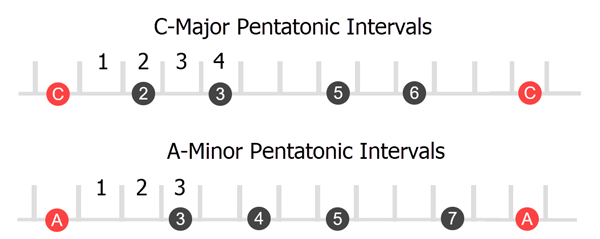Relative Minor and Major Scales
Before we discuss major pentatonic Freedom Blocks, I want to introduce you to relative scales. Surprisingly you can take any of the previous A minor pentatonic examples, and play them as C major pentatonic scales. How is that possible? How can the same Freedom Blocks be minor and major at the same time?
Answer: As Einstein would say, "It's relatively easy."
"I live my daydreams in music. I see my life in terms of music… I get most joy in life out of music."— Albert Einstein
Every major scale has a relative minor scale and every minor scale has a relative major scale. If that's not confusing enough, let me tell you that both relative scales use the same notes. Let me explain.
The easiest way to find the relative minor is to move down three frets from the major note. So A minor is the relative minor of C major.

Compare the Freedom Blocks and notes of the A minor and C major pentatonic scales. They're the same notes.

Your brain determines what scale you're playing by how it sounds. It listens for the root by noticing which note you emphasize, for example the note you start on.
It also listens to the intervals between the root and other notes. If the 3rd note of the scale is flat, one fret closer to the root, your brain interrupts that as a minor key. Below you can see that the third interval in the minor pentatonic scale is one fret closer to the root.

Both scales have three narrow intervals and two wide intervals. Their notes are the same, so the only difference is the order of the intervals and which note is the tonal center or root.
Notice that the wide A to C interval is at the end of the C major pentatonic scale and it's at the beginning of the minor pentatonic scale.

You can see the similarity of the two scales better when I shift one of the scales. Most of the intervals line up except for the wide intervals. Your ear is able to detect that slight difference, making one scale a "happier" major scale and the other a minor "sad" sounding scale.

Below are the A minor and C major pentatonic scales. The only difference is the order of the intervals and the starting note or root.
(A minor pentatonic: E5-8, A5-7, D5-7, G5-7, B5-8, E5)
(A major pentatonic: E7, A5-7, D5-7, G5-7, B5-8, E5-8)

Relative minor and major keys give you more options when soloing. Start a C major backing track and experiment playing the previous two sequences over that track. First, try a C major pentatonic. Then try an A minor pentatonic. Both will work, but each adds a different flavor to your solo.
Next, we'll talk about major pentatonic Freedom Blocks.